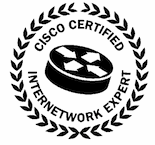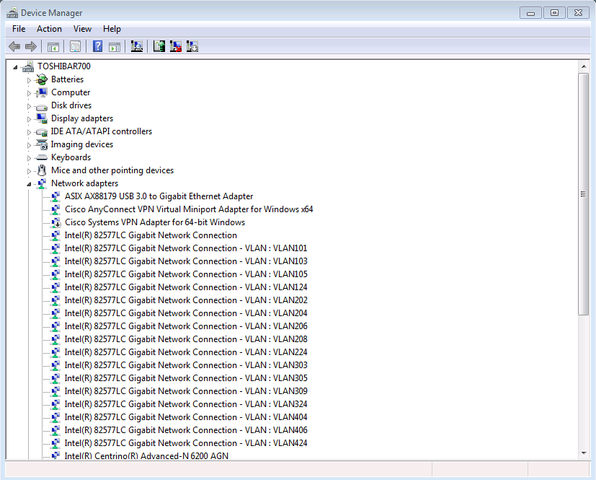Preparing for the CCIE labe at home
Perhaps I'll start with a brief introduction to the Cisco CCIE exam.
The history of CCIE began in 1993. Initially, the exam consisted of a two-day laboratory work, and later it was reduced to one day. According to Wikipedia, less than 3% of Cisco specialists succeed in becoming the happy owner of a CCIE certificate.
The exam itself consists of two parts: written and laboratory. The lab is given 8 hours.
There are several tracks: “Routing and Switching” (Routing and Switching); Security; “Service Provider”; Voice Transmission (Voice), etc.

Preparing for the CCIE "Routing and Switching" I started about 2 years ago. I had about 6 years of experience with network technologies and successfully passed the CCNP exam.
')
After successfully passing the written exam, I proceeded to prepare for the lab. For preparation, I chose materials ine.com, which are quite popular among those preparing for the exam.
There are several ways to prepare for the laboratory:
1. Purchase of all necessary equipment, and these are about 9 Cisco routers and 4 switches. On ebay, you can buy a ready-made set for $ 2,000 - $ 2,500 plus shipping.
Here is what is included in the standard set:
2 x Cisco 2610XM
1 x Cisco 2611XM
3 x Cisco 1841
2 x Cisco 2501
1 x Cisco 2522 / (or 2600 with NM-8A / S) (Frame Relay Switch)
1 x Cisco 2511 (Access Server)
2 x Cisco Catalyst 3550 Switch with EMI image
2 x Cisco Catalyst 3560 Switch with EMI Image
2. The second option is to rent equipment. Where for an hourly fee you get access to the necessary equipment.
3. The third option is to use Cisco IOS emulation software, such as Dynamips, for example.
Each of these options has its pros and cons. I stopped at the third option, as in the budget. To emulate Cisco routers, I stopped at GNS3 . GNS3 is a GUI for Dynamips. True GNS3 has a minus. It cannot fully emulate Cisco Catalyst switches. And this is due to the fact that Cisco uses ASIC processors for some of the functionality.
So I had to use physical switches and emulate routers using Dynamips.
The most difficult task, in my opinion, was to make real switches communicate with virtual routers.
I had 3 Cisco Catalyst 3750s borrowed at work and two used Cisco Catalyst 3550s bought on ebay for $ 80 each.
To emulate Cisco routers, I used a Toshiba R700 laptop with the following configuration: Intel Core i3 2.27GHz processor with 4 gigabytes of memory and a Windows 7 Professional 64-bit operating system.

The first time had to adjust everything in place. In the future, I have already connected via remote access.

The topology of INE is as follows.
To connect the GNS3 router to the physical switch, I decided to use the 802.1q trunk. This requires that the network card on the laptop supports VLAN tags.
My Toshiba R700 had an Intel network card that supported VLAN tags. But for this it was necessary to download and install ANS Teaming Software from Intel. I had to spend enough time before achieving the desired result.

Network adapter with multiple virtual adapters.
I used one of the Cisco 3750s as a Breakout switch, that is, as a link between GNS3 devices and the four physical switches that are needed directly for labs.

Breakout switch

Topology in GNS3.
This is the configuration on the port to which the laptop is connected:
interface GigabitEthernet2 / 0/24
description *** TRUNK TO THE LAPTOP ***
switchport trunk encapsulation dot1q
switchport trunk allowed vlan 2-4094
switchport mode trunk
l2protocol-tunnel cdp
l2protocol-tunnel stp
l2protocol-tunnel vtp
no cdp enable
spanning-tree portfast
This is the configuration of the port to which one of the physical switches is connected.
interface GigabitEthernet2 / 0/3
description *** VLAN105 TO THE SW1 ***
switchport access vlan 105
switchport mode dot1q-tunnel
l2protocol-tunnel cdp
l2protocol-tunnel stp
l2protocol-tunnel vtp
no cdp enable
spanning-tree portfast
To avoid a headache, I changed the MTU value for all network adapters from the standard 1500 to 1536, thus:
netsh interface ipv4 set subinterface "LAN101" mtu = 1536 store = persistent
By the way, you can check the current MTU size on windows like this:
netsh interface ipv4 show subinterface
To connect to each of the physical hubs, I needed an additional USB hub, with the necessary number of USB-to-Serial adapters connected to it. The price for Amazon is $ 19, but it can be found cheaper.

I use SecureCRT to work with Cisco.
I hope the above text will be useful to someone on the difficult path to the CCIE. I registered my CCIE Lab for July 2014. Next time I will try to tell you what the exam is in practice.
The history of CCIE began in 1993. Initially, the exam consisted of a two-day laboratory work, and later it was reduced to one day. According to Wikipedia, less than 3% of Cisco specialists succeed in becoming the happy owner of a CCIE certificate.
The exam itself consists of two parts: written and laboratory. The lab is given 8 hours.
There are several tracks: “Routing and Switching” (Routing and Switching); Security; “Service Provider”; Voice Transmission (Voice), etc.

Preparing for the CCIE "Routing and Switching" I started about 2 years ago. I had about 6 years of experience with network technologies and successfully passed the CCNP exam.
')
After successfully passing the written exam, I proceeded to prepare for the lab. For preparation, I chose materials ine.com, which are quite popular among those preparing for the exam.
There are several ways to prepare for the laboratory:
1. Purchase of all necessary equipment, and these are about 9 Cisco routers and 4 switches. On ebay, you can buy a ready-made set for $ 2,000 - $ 2,500 plus shipping.
Here is what is included in the standard set:
2 x Cisco 2610XM
1 x Cisco 2611XM
3 x Cisco 1841
2 x Cisco 2501
1 x Cisco 2522 / (or 2600 with NM-8A / S) (Frame Relay Switch)
1 x Cisco 2511 (Access Server)
2 x Cisco Catalyst 3550 Switch with EMI image
2 x Cisco Catalyst 3560 Switch with EMI Image
2. The second option is to rent equipment. Where for an hourly fee you get access to the necessary equipment.
3. The third option is to use Cisco IOS emulation software, such as Dynamips, for example.
Each of these options has its pros and cons. I stopped at the third option, as in the budget. To emulate Cisco routers, I stopped at GNS3 . GNS3 is a GUI for Dynamips. True GNS3 has a minus. It cannot fully emulate Cisco Catalyst switches. And this is due to the fact that Cisco uses ASIC processors for some of the functionality.
So I had to use physical switches and emulate routers using Dynamips.
The most difficult task, in my opinion, was to make real switches communicate with virtual routers.
I had 3 Cisco Catalyst 3750s borrowed at work and two used Cisco Catalyst 3550s bought on ebay for $ 80 each.
To emulate Cisco routers, I used a Toshiba R700 laptop with the following configuration: Intel Core i3 2.27GHz processor with 4 gigabytes of memory and a Windows 7 Professional 64-bit operating system.

The first time had to adjust everything in place. In the future, I have already connected via remote access.

The topology of INE is as follows.
To connect the GNS3 router to the physical switch, I decided to use the 802.1q trunk. This requires that the network card on the laptop supports VLAN tags.
My Toshiba R700 had an Intel network card that supported VLAN tags. But for this it was necessary to download and install ANS Teaming Software from Intel. I had to spend enough time before achieving the desired result.

Network adapter with multiple virtual adapters.
I used one of the Cisco 3750s as a Breakout switch, that is, as a link between GNS3 devices and the four physical switches that are needed directly for labs.

Breakout switch

Topology in GNS3.
This is the configuration on the port to which the laptop is connected:
interface GigabitEthernet2 / 0/24
description *** TRUNK TO THE LAPTOP ***
switchport trunk encapsulation dot1q
switchport trunk allowed vlan 2-4094
switchport mode trunk
l2protocol-tunnel cdp
l2protocol-tunnel stp
l2protocol-tunnel vtp
no cdp enable
spanning-tree portfast
This is the configuration of the port to which one of the physical switches is connected.
interface GigabitEthernet2 / 0/3
description *** VLAN105 TO THE SW1 ***
switchport access vlan 105
switchport mode dot1q-tunnel
l2protocol-tunnel cdp
l2protocol-tunnel stp
l2protocol-tunnel vtp
no cdp enable
spanning-tree portfast
To avoid a headache, I changed the MTU value for all network adapters from the standard 1500 to 1536, thus:
netsh interface ipv4 set subinterface "LAN101" mtu = 1536 store = persistent
By the way, you can check the current MTU size on windows like this:
netsh interface ipv4 show subinterface
To connect to each of the physical hubs, I needed an additional USB hub, with the necessary number of USB-to-Serial adapters connected to it. The price for Amazon is $ 19, but it can be found cheaper.

I use SecureCRT to work with Cisco.
I hope the above text will be useful to someone on the difficult path to the CCIE. I registered my CCIE Lab for July 2014. Next time I will try to tell you what the exam is in practice.
Source: https://habr.com/ru/post/206478/
All Articles